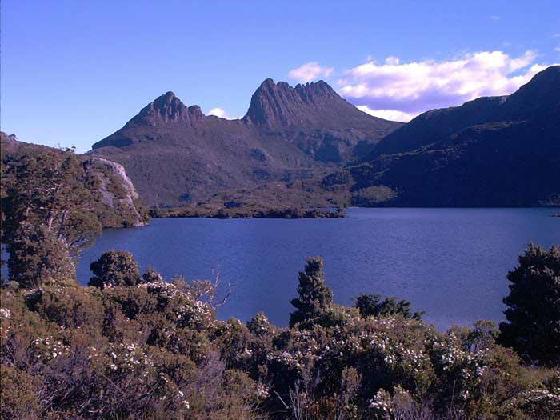
home •
about •
essential guide •
picture of the day •
thunderblogs •
news •
multimedia •
predictions •
products •
get involved •
contact
picture of the day archive subject index
Cradle Mountain with Dove Lake in the foreground. Credit: touringtasmania.info
Jun 09, 2008
Cradle Mountain, Tasmania
Australia’s wild country exhibits some of the most unusual geology found anywhere on Earth. Could the dolerite structures in Tasmania be electrical formations?The Island of Tasmania in the south of Australia is one of the most provocative spots on Earth. The remarkable diversity of plant life and the unique animals found nowhere else have provided scientists of every stripe with near-ideal conditions for study. The ecology is isolated, with little incursion from transplanted animals, although the rats that stowed away on early ships and the cats that were subsequently imported to kill the rats have had a dramatic (and sometime devastating) impact on the native animals.
Cradle Mountain might qualify as another example of the mysterious stone monoliths that are found on every continent (and under the sea). Unlike other Australian formations that are composed entirely of sandstone and a loose conglomerate of quartzite, sandstone, seashells and a collection of whatever minerals are found in the surrounding area, Cradle Mountain is a solid chunk of dolerite, or congealed basalt lava.
Tasmania illustrates violent geologic activity that took place “millions of years ago” according to conventional models. The mountainous uplifts, the deep, steep-sided gorges, the “needles” of stone that rise out of the ocean around its circumference and the many crater lakes found in the interior are said to be the remains of volcanic eruptions due to the movement of tectonic plates. Indeed, lava flows that buried valleys and snuffed-out jungles and forests are easy to see. The difficulty with the observation is that the features appear to be exceptionally fresh rather than extremely ancient. How do sharp needles of stone and vertical cliffs enclosing flat-bottomed channels come to exist through the slow process of erosion?
As most geologists propose, the erosive action of wind and rain tends to “melt” rock formations because rainwater is a weak form of carbonic acid and wind carries grains of dust that grind away at the stone over eons of time. Sharp points become blunted mounds; vertical walls become gently sloping hills, while river valleys mature from canyons into shallow meanders in a broad flood plain. It is counter-intuitive, therefore, to find youthful topography in a location that should have matured into old age millennia ago.
Cradle Mountain, in particular, is crowned with rock formations that seem to defy the elemental forces that are attempting to dissolve its very structure. Upright columns of dolerite stand like Easter Island statues in the rain. As standard mineralogical studies seem to indicate, basaltic lavas are often found eroded into columnar forms with a tendency to split into vertical fractures. On mountain peaks that are exposed to alternate freezing and thawing, the rainwater supposedly seeps into cracks in the stone where it freezes and expands, forcing the rock apart into slabs. Or, water finds the path of least resistance in the stone, carving vertical cracks ever deeper until, eventually, the rock falls apart.
In our Picture of the Day about the tepuis of Amazonia, we reported that on many of the summits rock formations that look more like abstract sculpture gardens are abundant. Stone points, thickets of tubular palisades and upraised, columnar “hands” with multiple fingers demonstrate that weathering cannot be the primary cause. How does erosion leave behind stacked stone towers with many layers, sharp edges, mushroom-shaped caps and fine detail? Figures such as those should have softened long ago. Cradle Mountain is crowned with an incredible number of similar oddities. The mountain, itself, resembles the South American massifs so closely that they could be cousins.
Dove Lake is one of many such “crater lakes” that can be found in the region. It is a bowl-shaped lake, very deep, scooped out of the bedrock. Around the lake are vertical cliffs that seem to indicate that Dove Lake is actually the bottom of a larger crater that is several kilometers in diameter. Lake Willis is another bowl-shaped lake located high above Dove Lake. Its overflow runs down into Dove Lake as a spectacular waterfall. Crater Lake, Lake Lilla and others are similar in shape. A particularly interesting detail is that these lakes appear to have been created by a kind of shotgun blast from space. They are clustered together, have nearly identical morphology and are “punched” into the strata, leaving it visible as multiple layers.
How did the Australian landforms come to be? If what has been taught since Lyell and Agassiz is correct, they were formed by glaciers, volcanism, erosion and other slow, steady, predictable forces that are supposed to be occurring invisibly all around us all the time. But if the Electric Universe hypothesis of planetary scarring is correct, they might have been created in an instant and in the recent past.
By Stephen Smith
___________________________________________________________________________Please visit our Forum
The Electric Sky and The Electric Universe available now!

|
|

|
EXECUTIVE EDITORS:
David Talbott, Wallace Thornhill
MANAGING EDITORS:
Steve Smith, Mel Acheson
CONTRIBUTING EDITORS: Michael Armstrong, Dwardu Cardona,
Ev Cochrane,
C.J. Ransom, Don Scott, Rens van der Sluijs, Ian Tresman
WEBMASTER: Brian Talbott
Copyright 2008: thunderbolts.info
![]()
home •
thunderblogs •
forum •
picture of the day •
resources •
team •
updates •
contact us

